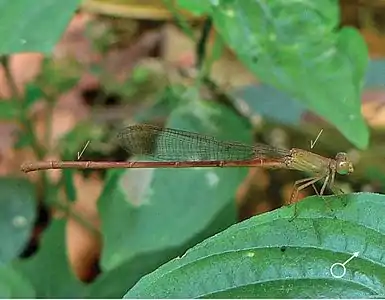| Ceriagrion olivaceum | |
|---|---|
 | |
| male | |
 | |
| female | |
| Scientific classification | |
| Domain: | Eukaryota |
| Kingdom: | Animalia |
| Phylum: | Arthropoda |
| Class: | Insecta |
| Order: | Odonata |
| Suborder: | Zygoptera |
| Family: | Coenagrionidae |
| Genus: | Ceriagrion |
| Species: | C. olivaceum |
| Binomial name | |
| Ceriagrion olivaceum Laidlaw, 1914 | |
| Synonyms | |
|
Ceriagrion aurantiacum Fraser, 1924[2] | |
Ceriagrion olivaceum[3] is a species of damselfly in the family Coenagrionidae. it is commonly known as rusty marsh dart.[4][5] This species can be found in south and southeast Asia.[1][6]
Subspecies
- Ceriagrion olivaceum olivaceum Laidlaw, 1914
- Ceriagrion olivaceum aurantiacum Fraser, 1924
Fraser described C. aurantiacum from southern India[2] but later concluded that it was a subspecies or race of C. olivaceum.[7] Asahina in his revision of Asian Ceriagrion compared both the specimens and decided to retain the race, stating the subapical tooth of superior caudal appendages differently shaped.[8] C. o. olivaceum is widespread in India and Southeast Asia. C. o. aurantiacum is only known from southwest India.[9]
Description and habitat
It is a medium-sized damselfly with olivaceous brown capped greenish eyes. Its thorax is olive green, paler on the sides. Its abdomen is throughout olivaceous brown on dorsal half and paler on the ventral half. Its superior anal appendages are brown and triangular when seen from the dorsum. The apex broadly rounded. The inferiors are sloping strongly up to meet the superiors, broad at base and tapering to a point. Female is similar to the male.[7]
It breeds in slow running marshy streams, ponds, and swamps.[7][2][10][4][5]
See also
References
- 1 2 Mitra, A. (2010). "Ceriagrion olivaceum". IUCN Red List of Threatened Species. 2010: e.T167147A6308337. doi:10.2305/IUCN.UK.2010-4.RLTS.T167147A6308337.en. Retrieved 20 November 2021.
- 1 2 3 C FC Lt. Fraser (1924). A Survey of the Odonate (Dragonfly) Fauna of Western India and Descriptions of Thirty New Species (PDF). p. 492.
- ↑ Paulson, D.; Schorr, M.; Abbott, J.; Bota-Sierra, C.; Deliry, C.; Dijkstra, K.-D.; Lozano, F. (2023). "World Odonata List". OdonataCentral, University of Alabama. Retrieved 14 Mar 2023.
- 1 2 "Ceriagrion olivaceum Laidlaw, 1914". India Biodiversity Portal. Retrieved 2017-03-02.
- 1 2 "Ceriagrion olivaceum Laidlaw, 1914". Odonata of India, v. 1.00. Indian Foundation for Butterflies. Retrieved 2017-03-02.
- ↑ K.A., Subramanian; K.G., Emiliyamma; R., Babu; C., Radhakrishnan; S.S., Talmale (2018). Atlas of Odonata (Insecta) of the Western Ghats, India. Zoological Survey of India. pp. 151–152. ISBN 9788181714954.
- 1 2 3 C FC Lt. Fraser (1933). The Fauna of British India, including Ceylon and Burma, Odonata Vol. I. Red Lion Court, Fleet Street, London: Taylor and Francis. pp. 324–326.
- ↑ Asahina, S. (1967) A revision of the Asiatic species of the damselflies of the genus Ceriagrion (Odonata, Agrionidae) Japanese Journal Zoology 15 (3): 255-334, figs. 1-237.
- ↑ Kalkman, V. J.; Babu, R.; Bedjanič, M.; Conniff, K.; Gyeltshenf, T.; Khan, M. K.; Subramanian, K. A.; Zia, A.; Orr, A. G. (2020-09-08). "Checklist of the dragonflies and damselflies (Insecta: Odonata) of Bangladesh, Bhutan, India, Nepal, Pakistan and Sri Lanka". Zootaxa. Magnolia Press, Auckland, New Zealand. 4849 (1): 001–084. doi:10.11646/zootaxa.4849.1.1. hdl:10072/398768. ISBN 978-1-77688-047-8. ISSN 1175-5334. PMID 33056748.
- ↑ Subramanian, K. A. (2005). Dragonflies and Damselflies of Peninsular India - A Field Guide.
External links
![]() Data related to Ceriagrion olivaceum at Wikispecies
Data related to Ceriagrion olivaceum at Wikispecies
![]() Media related to Ceriagrion olivaceum at Wikimedia Commons
Media related to Ceriagrion olivaceum at Wikimedia Commons
